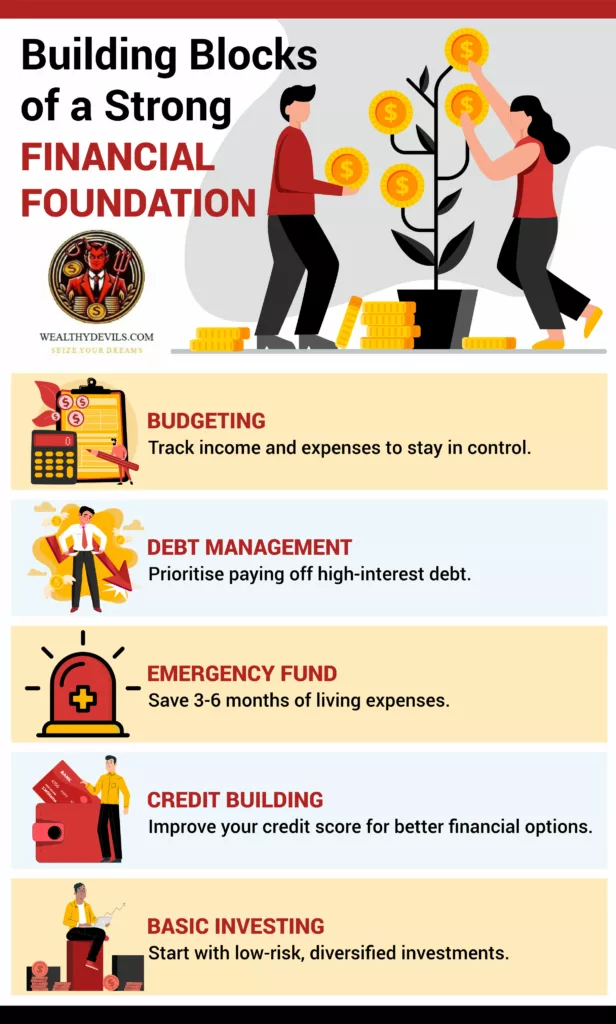Financial Foundations: Build Your Wealth Step by Step

Create a stable financial base for lasting success and peace of mind.
Why Financial Foundations Matter?
Before you can grow wealth, you need to lay the groundwork.
Building wealth begins with a strong financial foundation. Whether you’re starting from scratch or seeking to improve your financial habits, mastering the basics is essential. From effective budgeting to understanding credit and creating a robust savings strategy, these foundational skills empower you to take control of your financial future. By addressing the building blocks of personal finance, you’ll pave the way for long-term stability and success.
Start Your Journey: The Core Elements of Financial Foundations
A solid financial foundation is built on six key pillars:
| Pillar | What It Means | Actionable Steps |
|---|---|---|
| Budgeting | Managing income and expenses to meet goals. | Use apps like Switcheroo to monitor spending and optimise savings. |
| Debt Management | Reducing and consolidating debt for better control. | Prioritise high-interest debts and explore refinancing options. |
| Savings | Building reserves for emergencies and opportunities. | Automate deposits into a high-yield savings account. |
| Insurance | Protecting assets from unforeseen risks. | Invest in life, health, and business insurance policies. |
| Investments | Growing wealth through smart, diversified choices. | Start with low-cost index funds or explore guided options through the likes of Morningstar. |
| Financial Literacy | Understanding tools and strategies for success. | Explore guides on Premium Resources to master the basics. |
Building Strong Financial Foundations

This visual guide summarises the six pillars of financial foundations, illustrating how they interconnect to create a resilient financial base.
- What the Infographic Highlights:
- Budgeting: Examples of budgeting techniques, such as the 50/30/20 rule.
- Debt Management: A breakdown of debt repayment strategies like the Snowball and Avalanche methods.
- Savings: The importance of emergency funds and where to start.
- Credit Building: The compounding impact of understanding your credit score and how it affects your finance options.
- Investments: Benefits of diversification and starting small.
- How to Use It:
Print or download this infographic as a quick reference to stay focused on your financial goals.
Step-by-Step Plan for Financial Security
1. Create a Personal Budget
Your budget is your financial blueprint. Start by tracking your income and expenses to identify spending patterns.
Tips for Success:
- Categorise spending into needs, wants, and savings.
- Use tools like Switcheroo to reduce subscription and utility costs.
- Allocate 50% of your income to essentials, 30% to discretionary spending, and 20% to savings or debt repayment (50/30/20 rule).
2. Build an Emergency Fund
Why It’s Critical: Emergencies happen—medical bills, job losses, or unexpected repairs. Having 3–6 months’ worth of expenses saved can prevent financial setbacks.
Action Plan:
- Open a high-yield savings account for your fund.
- Automate monthly transfers to reach your target.
- Avoid dipping into your fund for non-emergencies.
3. Tackle Debt Strategically
Why It Matters: High-interest debt drains your wealth potential. Eliminating it frees up resources for savings and investment.
Two Key Strategies:
- Debt Snowball: Focus on paying off the smallest debt first to build momentum.
- Debt Avalanche: Prioritise the highest-interest debt for faster financial savings.
Tip: Look into refinancing or debt consolidation options to reduce interest rates.
4. Protect What You Have
Insurance: A safety net for your wealth and well-being. Ensure you’re covered in these areas:
- Life Insurance: Protects your loved ones in case of unforeseen events.
- Health Insurance: Prevents catastrophic medical expenses.
- Business Insurance: Shields your enterprise from legal or financial risks.
Explore digital security options like IT Governance to safeguard online assets.
5. Invest for the Future
Investing: The key to long-term growth. Start small and focus on diversification.
Actionable Tips:
- Begin with low-risk investments like index funds or government bonds.
- Reinvest dividends to maximise compound growth.
- Use tools like Morningstar to research investment opportunities.
6. Build Financial Literacy
Knowledge is your best asset. Stay informed about financial strategies, tax-saving tips, and wealth-building tools.
Recommended Resources:
- Visit our Premium Resources for step-by-step guides and templates.
- Subscribe to financial podcasts or read books by industry leaders.
Advanced Strategies for Long-Term Security
Once your financial foundation is solid, consider these advanced techniques:
| Strategy | Why It’s Valuable |
|---|---|
| Tax Optimisation | Minimise your tax burden and maximise returns with tools like Taxrefund. |
| Estate Planning | Ensure smooth wealth transfer through wills and trusts. |
| Multiple Income Streams | Diversify earnings to build resilience. Learn more in our Income Pathways. |
| Inflation-Proof Investments | Safeguard against inflation with assets like real estate or gold. |
Premium Resources: Elevate Your Financial Mastery
For deeper insights and practical tools, explore our Premium Resources, where you’ll find:
- Detailed guides on budgeting, debt repayment, and savings plans.
- Templates for building an emergency fund and tracking expenses.
- Case studies on successful investment strategies.
Next Steps: Grow Beyond the Foundations
Congratulations on setting the groundwork for financial success! The next step is to focus on growth and scaling. Visit our Income Pathways pathway to discover how to:
- Multiply your income streams.
- Unlock advanced investment strategies.
- Scale your wealth-building efforts with confidence.
Secure Your Financial Future Today
Strong financial foundations are the cornerstone of success. By mastering budgeting, debt management, savings, and investment, you’ll create a solid platform for long-term prosperity.
Take control, stay consistent, and let Wealthy Devils guide you every step of the way.
